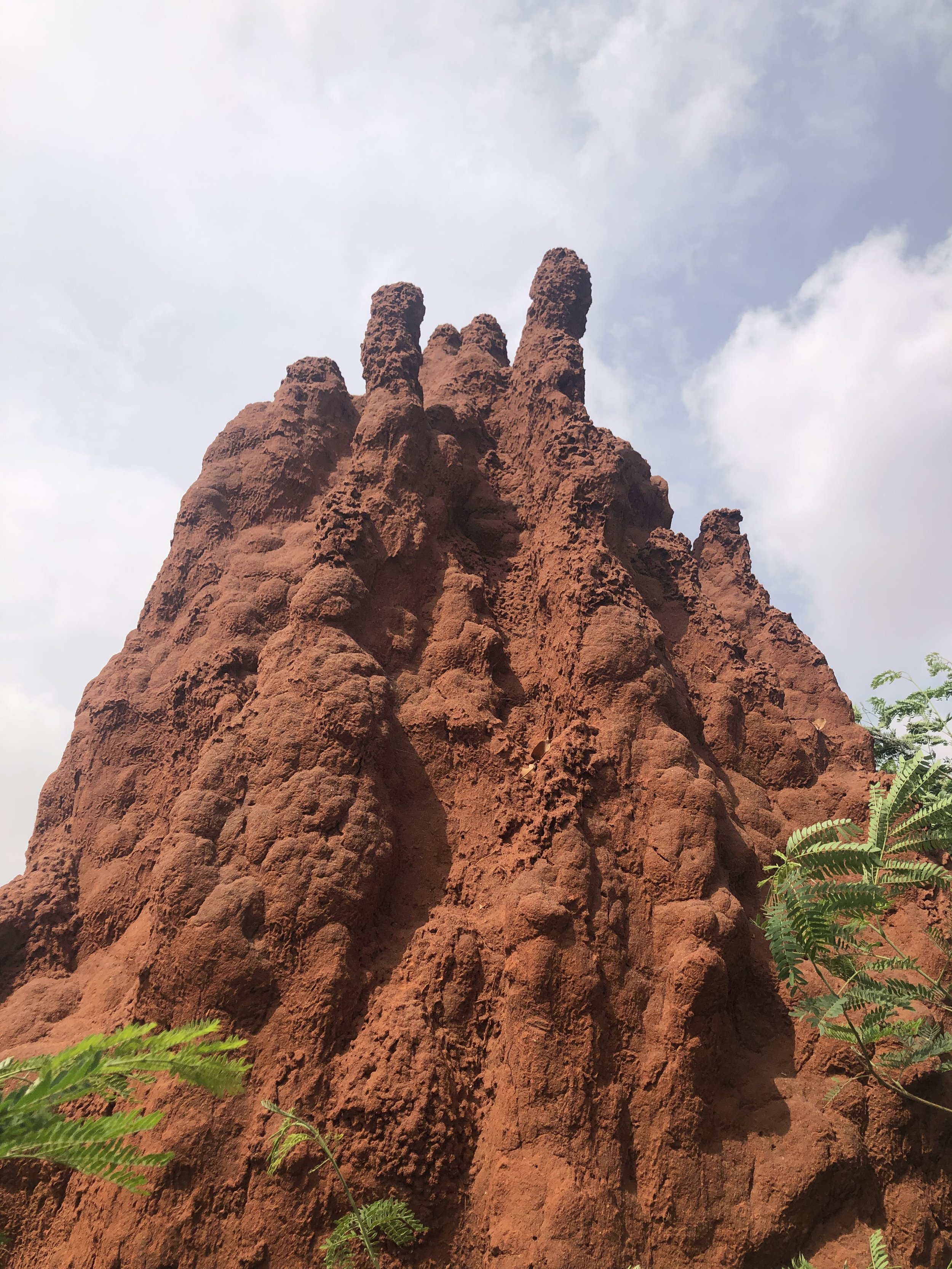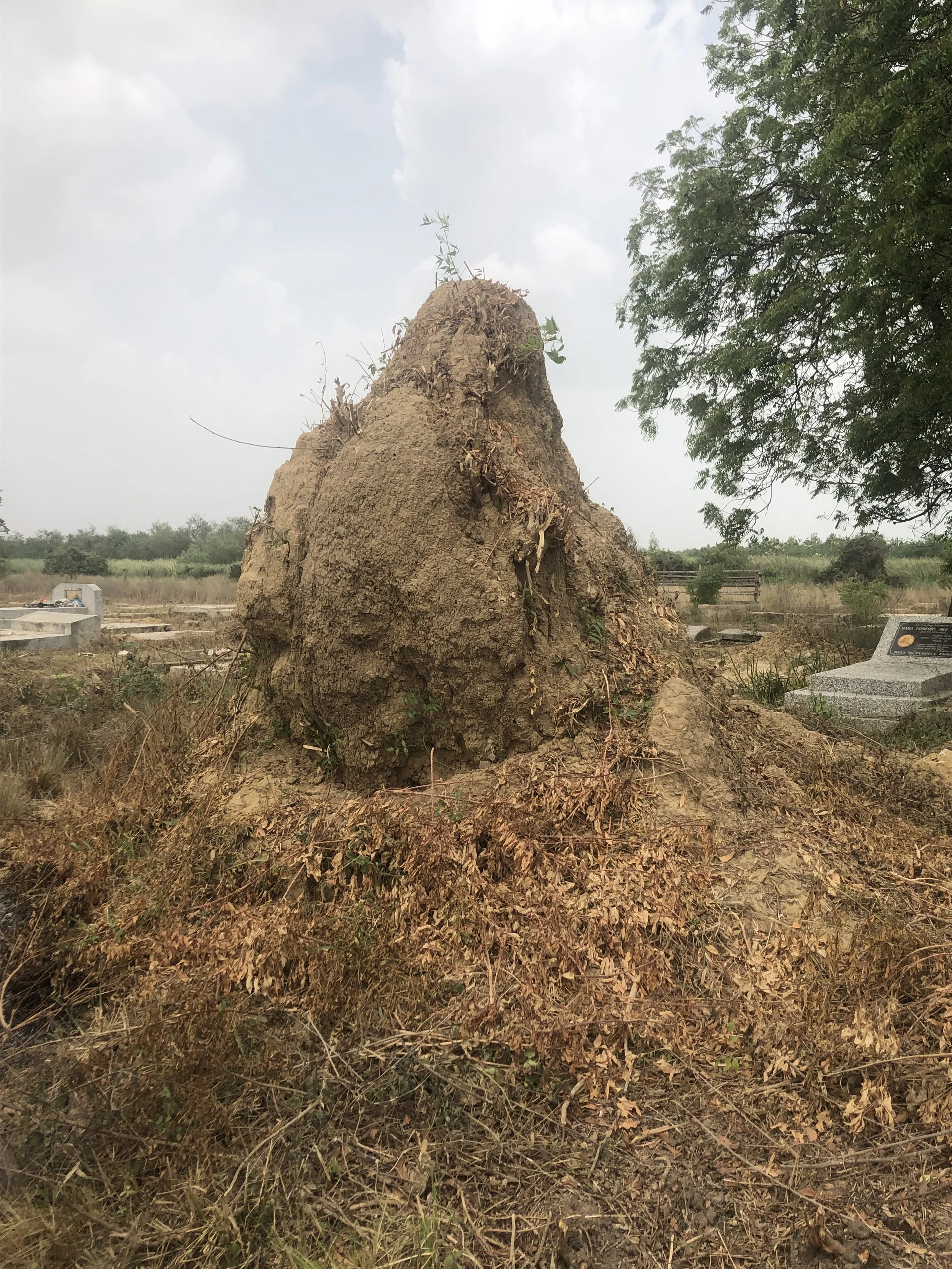Termite Architecture and More-than-Human Building
Architecture is not subject to humans. The ways in which species build their homes and habitations is a didactic way of understanding how the structure itself relates to the Earth and to ‘systems’. Why did they use the material they used? How did they build this? How does the structure choreograph movement ‘to and from’? What systems amongst the community arise in negotiation with the structure?
As humans, there is something we can learn about how animals build their home—through slowing this process down to reveal the complexities there is a relationship between material, aesthetics, community and even government amongst the species.
“It’s the fall of 2021 and I am travelling through Ghana, in a constructed route up the Volta river coast of sub-saharan Africa. There are termite mounds everywhere, and these earthly sky-rises have completely captivated my heart. These mounds proliferate throughout the landscape as if to be emerging as an extension of the landscape itself and I can’t help but think, “I must know the architect.”
RESEARCH
This observation has become a research project on more-than-human building, beginning with Termites.
Termite mounds are considered the sky scrapers of the desert, and they act as elaborate ventilation systems—breathable lungs ensuring the termite survival. They don’t actually live in the tower but in the underground channels which contain their food, eggs and queen. They only come up to the tower to make repairs or defend their colony, otherwise the tower itself is a self-operating porous construct—breathing in and out with the desert wind. The mound often outlives the colony and these structures are so architecturally sound that once they’ve been vacated, a new resident can simply move in. The idea is that everything about the mound is circular and connected—a closed loop system. The termite takes from the Earth (soil, wood etc.)—transforms it, and overtime the structure will return to the earth again.
Many people think that it’s only the termite who constructs these masterful mounds, but they actually couldn’t do it without outsourcing and thus co-habitating with the Termitomryces Fungi—a testament to the fact that we live in a world of divergence, convergence and collaboration. The fungi digests the wooden ligaments, and the termites use that substance to build.
I am pleasantly surprised at the concept of what it means to observe, study and learn from nature. The termite has truly done something spectacular. As Anna Tsing says:
“Making worlds is not limited to humans. We know that beavers reshape streams as they make dams, canals, and lodges; in fact all organisms make ecological living places, altering earth, air and water. Without the ability to make workable living arrangements, species would die out.”
INITIATING OR ACTIVATING WITHIN ARTS PRACTICE
Art activates knowledge. One of the ways in which my knowledge of more-than-human architecture has expanded is not only through research but through the doing-ness or the praxis of acting on the knowledge through creating. The research I conducted on the termite—the ritualistic way they move to and from the mound altar, the fungal collaboration they are so deeply entangled with and the use of local earth material became thinking points for a project entitled Garden 404, initiated by Open Set. In this project, the director and I engaged in a letter writing correspondence of building our “mounds” in separate places. Documenting the conscious choice of location, the ritual of walking to- and from-, gathering material, “out sourcing” the help of my brother to build the mound, reflecting on the experience in tandem to where I was in that moment of life—all fall into what it means to build, perhaps even we can call this ‘building material.
More information and documentation of the project can be found here.
“Dear I,
I was born and raised a Caribbean girl. As I’ve grown older, I’ve become so proud of my Island Jamaica and so proud of my revolutionary yet divergent history—like my own body is a lump of soil, and the entanglement of stories and ancestry from all over decided to meet here. My mother is Jamaican-Portuguese, and my father is Scottish-Trinidadian.
From an early age till now, I am always the first one to rise. Even as a little girl, I felt there was something so sacred about rising with the sun, to the point where I created my own ritual of climbing on the roof just to greet it. Our island home consisted of a slab roof—a flat, horizontal concrete surface that protected our home from hurricanes when the season came. It was easy to climb this roof, and once I got to the top I would sit with my blanket and watch the market ladies walk down Blue Mountain. Their head tops were filled with barrels of ackee, plantain, bananas, and mangoes—Earth bounty! And when they walked, they sang, with their hips swaying from side to side like an oscillating ocean. Their heavy barrels seemed weightless in their sway and the more I watched them, the more I felt their strength, honour, purpose and ritual. To do this walk every morning at 5am without question was something so honourable. They walked, and they found joy in the walking—the singing, smiling and basking in our native dialect patois. That was the language of our culture, the language of the people and a language so animated that it allows me to resonate with what you say about Russian. The spirit comes through the language right? We weren’t allowed to speak it in school or in specific institutions, which is typical of a post-colonised nation where one is taught to reject the culture in order to achieve the colonial objective. At school we spoke proper British-English and at home, we held each other in patois.
This morning on my walk to the mound, I held this memory. I used to love watching the market ladies walk this long distance down the mountain and perhaps I chose to build or initiate the mound at a longer distance than my home in order to rehearse, or re-perform this memory.
This project is part of a large work of research on Multispecies Architecture.







